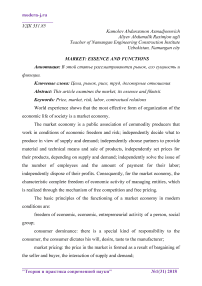Market: essence and functions
Автор: Kamolov A.A., Aliyev A.R.U.
Журнал: Теория и практика современной науки @modern-j
Рубрика: Международные экономические отношения
Статья в выпуске: 1 (31), 2018 года.
Бесплатный доступ
This article examines the market, its essence and fikntsii.
Price, market, risk, labor, contractual relations
Короткий адрес: https://sciup.org/140289454
IDR: 140289454
Текст научной статьи Market: essence and functions
World experience shows that the most effective form of organization of the economic life of society is a market economy.
The market economy is a public association of commodity producers that work in conditions of economic freedom and risk; independently decide what to produce in view of supply and demand; independently choose partners to provide material and technical means and sale of products, independently set prices for their products, depending on supply and demand; independently solve the issue of the number of employees and the amount of payment for their labor; independently dispose of their profits. Consequently, for the market economy, the characteristic complete freedom of economic activity of managing entities, which is realized through the mechanism of free competition and free pricing.
The basic principles of the functioning of a market economy in modern conditions are:
freedom of economic, economic, entrepreneurial activity of a person, social group;
consumer dominance: there is a special kind of responsibility to the consumer, the consumer dictates his will, desire, taste to the manufacturer;
market pricing: the price in the market is formed as a result of bargaining of the seller and buyer, the interaction of supply and demand;
contractual relationship;
competition;
state regulation of the market and market relations (as state regulation instruments, taxation, financial and credit and banking system);
openness of the economy: economic organizations and entrepreneurs have the right to carry out foreign economic operations subject to certain conditions and restrictions;
ensuring social protection of the population.
In economic literature there is no single definition of the essence of the market. In everyday life, the market is understood primarily as space (place, territory, zone), where the purchase and sale of goods. This space can be a trade hall for a store or exchange, the territory of a rural or urban market, the territory of an administrative district, the state or several held territory of the world.
Many economists consider the market as a phase of the exchange of the process of recreation. Recreation as a continuous process of recurrence and resumption of production includes production, distribution, exchange and consumption. Of these four simple moments of recreation, the market is limited to only one - exchange. In the economic literature, there are other definitions of the concept of the market. Individual authors identify it with trade or with the sphere of circulation.1
In many definitions of the market, attention is focused on the system of relations between people. Among these definitions, the most common are the following:
-
- The market is an institution, or a mechanism that brings together buyers (demanders) and sellers (suppliers of individual goods and services);
-
- The market means a group of people who enter into close business relationships and enter into important agreements for any product;
-
- the market is a relationship between people that manifest themselves through an exchange that functions on the basis of the laws of commodity production and circulation.
Each of these definitions reflects certain aspects of market relations. However, the advantage should be given to the latter. The fact is that building a market only for exchange or trade is inexpedient. This would mean that to change from an administratively commanded management system to a market economy, it is enough to restructure only the sphere of exchange. In reality, however, this process is much more complicated and for its implementation a radical restructuring of all spheres of economic activity is necessary: the spheres of production, the sphere of distribution, the sphere of exchange and the sphere of consumption.
The main socio-economic conditions for the emergence and functioning of the market are:
firstly, the social division of labor, through which specialization of producers takes place in the production of specific products;
second, the economic isolation of individual producers as owners. In other words, we are talking about a variety of forms of ownership, among which the main place is occupied by private property.2
The market is a system of economic relations connected with the exchange of goods and services on the basis of a wide use of various forms of ownership, commodity-money and financial-credit mechanisms.
Stages of market formation:
-
- the classical free market (by the middle of the 19th century), in which the state did not interfere in the economy, acting as a "night watch", which ensured that everyone who has an independent source of income carefully paid taxes to the state treasury;
-
- The regulated market (mid XIX - 50th years of the XX century) was characterized by state interference in the economic life of the society with the aim of limiting the willfulness of monopolies and protecting the competitive environment;
-
- the social market is oriented in which, in addition to the regulatory mechanisms, the state assumes the function of social protection of the population.
There are two sectors of the economy: market and non-market (state).
Список литературы Market: essence and functions
- Умарова Г. Ш. Роль иностранных инвестиций в развитии национальной экономики //International scientific journal. - 2016. - №. 3. - С. 148-149.
- Камолов А.А. Внешнеэкономическая деятельность Узбекистана"Теория и практика современной науки 5 (2017): 958-961.


